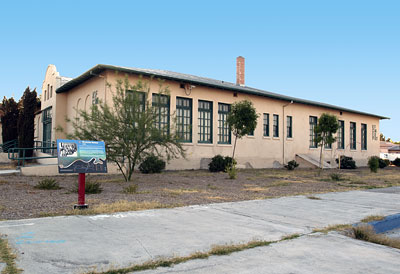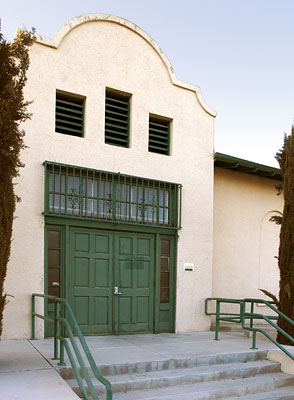National Register of Historic Places in Clark County
Westside School
Washington and D Streets
Las Vegas
Built 1923
The first school in West Las Vegas opened with two rooms and two teachers for four grades.
From 1903 until 1923, children from McWilliams' Townsite crossed the railroad tracks to get to school in Clark's Townsite. This dangerous situation lasted until the Las Vegas School District built this two-room school on land in the new Valley View addition, adjoining Mc Williams' Townsite on the east.
The school quickly expanded with two more roms in 1928 when news of the construction of Hoover Dam brought families from the south searching for work. A kindergarten was added in 1938, and in 1942 a small building from the Civilian Conservation Corps camp was moved to the site to house third and fourth grades. Fifth grade was added in 1947. Finally, in 1948, a concrete block addition was built next to the original school building to house sixth, seventh, and eighth grades. In May 1949, twenty-seven students graduated in the first eighth grade commencement class.
New neighborhoods and schools to serve them came quickly in to 1950s. The Westside School was phased out for school use in 1967, and became a city property in 1974. Shortly thereafter, the city leased the building to the Economic Opportunity Board (EOB) as a community center and radio station.
Source: Pioneer Trail Route interpretive marker shown in the top photograph. The Westside School is site 12 on the route.

The following narrative describes the Westside School in 1979 when it was nominated for the National Register of Historic Places.
The Westside School is an empty school complex containing Las Vegas' oldest remaining schoolhouse. It is located in the core of Las Vegas' worst census district from a poverty standpoint and is adjacent to the nine other districts that comprise the "Top Ten" in poverty.
The school...is easily visible from the freeway and, in its present condition, does not present an attractive picture of what is the first branch of the Las Vegas Grammar School.
Though time and indifference have taken their toll, the building retains an appearance of quiet dignity. To preserve its architecture, characteristic of the era in which it was built, would be a source of pride to the citizens of the community as well as a way by which a part of Las Vegas history would be preserved for future generations of Nevadans and Clark County residents.
The school is presently closed and boarded to prevent entry. The original 1922 portion was constructed in a modest Mission Revival style; possessing a centrally placed curvilinear parapet wall which denotes the main entry.
Source: NRHP Nomination Form

